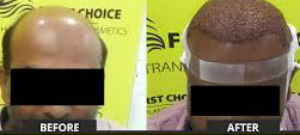What To Expect About Hair Transplant Recovery
What To Expect After Your Hair Transplant Procedure
How Long Does Hair Transplants Take To Heal
Healing often varies from patient to patient and it is also dependent on the number of grafts a patient has and the type of hair transplant method been used – FUE or Strip FUT.
If you have FUE hair transplant, then you will have the sides and the back of your head shaved. If you are not concerned with a ‘shaved’ look, then you may return to work within 2 – 3 days. Some patients went back to work the following day after their hair transplant procedure, wearing a hat.
The small holes in your donor site will heal within one to two days. FUE scars heal in a couple of days and recovery is fast. You will likely not have any visible marks at the end of a week. Because of the shave on the back of your head, most FUE patients typically take off from work for five to seven days following their FUE hair transplant procedure so that there will be no trace of the transplant.
If you have a strip FUE hair transplant, you will not have the back of your head shaved down. However, there will be a scar running across your donor site which is the back of your head. The donor site can be completely hidden well with your existing longer hair above it. Most women grow their hair long so they can hide their donor sites well under a long length of hair.
This means that no one can tell that you have undergone a hair transplant as the donor site is completely hidden immediately following the surgery. And in about 8 to 10 days, the scabs at the donor site will be gone.
Regardless of which of the above hair transplant techniques your surgeon use, you will have thousands of tiny little crusts in your recipient area which is likely to be the front and top of your head. You may not be able to conceal these little scabs and swelling completely with your pre-existing hair. If you cannot style your pre-existent hair over this area, then be expected to have these scabs being visible for about 1 – 2 weeks following the procedure.
After about seven to ten days following your surgery, most patients can be comfortable being out and about, and no one will notice much. If you have important events like weddings or important business meetings then it is better to give yourself a month, to be safe.

You should wash the recipient area daily with the use of a sponge filled with soapy water to keep the area free of crusts. All crusts can be washed off by pressing the sponge on the recipient area, without worrying about losing grafts. Rolling the sponge on the crusts to lift them off, but never rub them. With the daily wash, the crusts from your donor area will be gone in 7-10 days.
How Soon Can You Resume Exercise After Hair Transplant Surgery
You should have adequate rest, during the first week after the surgery, to allow the head and body to recover well from the procedure. Be patient with your recovery so you can get the best possible results of your hair transplant procedure. Do not try to rush back to any form of strenuous activities like vigorous aerobic exercise and weight training until three weeks after the procedure. You should stay away from strenuous physical activities for at least two weeks following the procedure. In fact, the longer you wait to exercise following your hair transplant, the better.
Try your best to wait at least two weeks before resuming light exercise. You can gradually get back to an exercise regime starting with cardio and then slowly adding back power weight training later. During your exercise, if you experience pain in your incision area, it is likely that you are stretching the incision so you should stop the activity that causes the pain.
After the four weeks mark, you can safely pursue all exercise activities. If you have any doubt, it is always recommended that you consult your Singapore FUE surgeon as he or she knows the details of your situation and will be able to give you the appropriate advice.
Hope you find the above information helpful. For more details about the hair transplant procedures, you can visit HairTransplantSingapore.net to learn more.
